Here is the link to my final presentation!
Author: Salome Mindiashvili
Self Evaluation
My experience as a marketing & communications intern at Lower Manhattan Cultural Council has been very valuable. Since the beginning of my internship, my projects have been getting more and more challenging and I believe that my workflow in this process has been very efficient. Although in the beginning of my internship, I did not have any in-depth, formal training in the projects and tasks I would be working on, I learned and adapted fairly quickly and was able to complete all the required tasks without many revisions.
I stayed open-minded and was always willing to offer my skills and interests in the areas that my team did not expect of me. I worked on various design projects and did a photoshoot for one of their artist-in-residence programs which was greatly welcomed and used on all LMCC digital platforms.
Besides all the creative projects, I also worked on several administrative and research projects. I was there to learn, develop my skills further and to leave a good impression.
Overall, I’m quite happy with my internship experience and all the things I have learned and acquired from it. Although I do wish I did more design-related projects and less administrative tasks, I’m still very satisfied with the overall outcome. I will be continuing my employment at LMCC in a week as an independent contractor where I will have more opportunity to work on design-related projects.
What I’m Learning #3 | Saying No
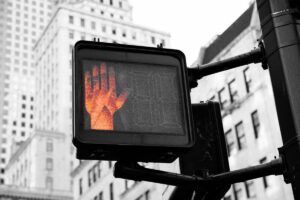
I have always struggled to say no. At work, there are some exceptional times when saying no can be an option. At the beginning of my internship, I offered my internship company my photography services without any charge. I had been stuck at home for a while due to the pandemic and the opportunity to go out to LMCC’s Arts Center in Governors Island, play with my camera and photograph artists sounded exciting. I spent two full days photographing 12 artists, then I went through all the images and following the company’s file naming process, renamed and coded all those files. This turned out to be a lot more work than I originally expected. Nevertheless, I was happy that photographs turned out beautiful and that my work was all over the Instagram pages of the New York City art scene as well as our social media pages and the website.
About three months later, I was asked If I could photograph new members of the artist-in-residence program again. I agreed but due to the delays in my flight from Georgia to the US, I was unable to do it and instead, my company hired a photographer. While sharing images that I was going to use for later social media and news posts, I was copied on the emails between the photographer and my supervisor. One of those emails being the invoice the photographer had sent to my supervisor requesting $600.00 ($300/day). Although, financial gains never being my number one career motivator, I still found this worth noting.
Last week, my supervisor asked me to photograph a new group of artists-in-residence on a day that I’m not scheduled to work. In addition, she does know that now I live in Connecticut and commuting from here all the way to Governors Island for two full days would be very exhausting. I also thought to myself that if the photoshoot is so important, instead of asking me to go out of my way and provide my services for free, she could hire the same photographer as the last time.
This time, I could not say yes and explained to her that my commute from Connecticut to Governors Island and photographing artists for two full days would be very exhausting for me and that was something that I was not willing to do. I think that saying no at times takes courage but it is very important to set the boundaries and protect your own time especially when it’s something that’s not required of you.
What I’m Learning #2 | Collaborative Project
Along with many other artist residency programs, every year LMCC organizes a SU-CASA program which is a community arts engagement program for older adults. The program supports Manhattan-based artists and organizations engaging participating older adults throughout the borough in the creation of an art project or series of cultural programs.
During the program, experienced teaching artists and community arts organizations are offering hands-on arts classes (this year remotely) for older adults to explore an artistic practice. All classes are free and require no previous experience. SU-CASA online classes focus on dance, music, theater, visual arts and writing.
I was asked to help the program coordinator with whom I had not worked with the visual design of a flyer and a class schedule. There were three of us going back and forth, including the SU-CASA coordinator and another communications team member. We had several meetings on the direction of the designs after which the coordinator decided to go with the visual design of a class schedule as opposed to a simple flyer.
Since I had other ongoing projects, the SU-CASA program coordinator decided to create a schedule herself and my supervisor asked me to refine it. Since design is usually an ongoing process, I had to discuss several things with her and refine the design multiple times. Below are the schedule designs before and after my revisions. This was another valuable design project as well as an experience in collaborating with others and coming to a conclusion of a project that takes all perspectives into consideration.
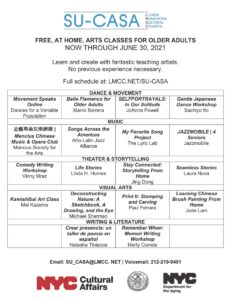
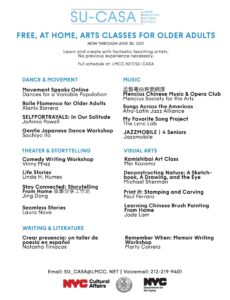
What I’m Learning #1 | Internship Experience
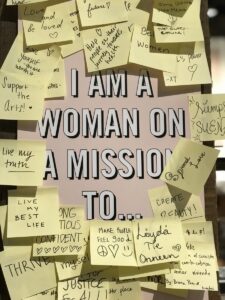
One of the most useful tools I have learned so far being at my internship is using multiple social media scheduling and analytics tools like Iconosquare and Hootsuite. We try hard to stay active on LMCC’s social media platforms and post daily on Twitter, Facebook, and Instagram. Therefore, utilizing social media scheduling and analytics programs is very useful. I have never had to use programs like Iconosquare and Hootsuite before and the fact that we can plan the posts for the week, schedule, and get insights on them is a great learning experience.
Besides the social media scheduling, I am also responsible for checking LMCC’s info email throughout the day. I usually go through the inbox and either reply or forward emails.
After sending our monthly newsletter through Mailchimp, we often get hundreds of emails from recipients notifying us either about the email change or the delivery failure. It is one of my responsibilities to go through these emails every month and update the mailing audience so that the list of future newsletter recipients is up to date.
Work Culture at LMCC

The culture at LMCC is quite relaxed and the attire is informal which makes me realize that I will never want to work for a company where I’m forced to dress in a certain way, not be comfortable with my tattoos/piercings and hide expressive parts of my personality. I used to work for a corporate company before enrolling back in school and being forced to dress a certain way and act very modest was very uncomfortable for me. I believe that what should count are the skills and the dedication of an individual, not how she/he dresses.
My typical day at LMCC is a 5-6 hour working day, twice a week, on Wednesdays and Fridays. Although I might be entitled to take a lunch break, I almost never do since I’m usually very busy with projects and daily tasks.
Getting an Internship | From CUNY Culture Corps. to LMCC
In Fall 2019, I took the Digital Media Foundations class which was taught by Prof. Goetz who also happened to be an internship coordinator at City Tech. After completing several projects, Prof. Goetz encouraged me to apply for a CUNY Culture Corps., before becoming a senior. CUNY Culture Corps., which provides paid work experience in civic-oriented jobs sounded like a perfect internship and I sent my application as soon as the program became available for the 2020-2021 year.
The application process was lengthy and included multiple steps like a personal statement essay, multiple interviews, and a waiting time of approximately 8-9 months. Luckily, I was selected for the program after which, we were required to complete the professional workshops and started preparing for an online job fair. The job fair was the most important event of this program through which, students were encouraged to apply for hundreds of positions at various cultural organizations and interview through Zoom and Google Meet.
I applied for 10 positions that were related to my professional field and I was paired with Lower Manhattan Cultural Council as a Communications & Marketing Intern. Although my number choice organization was the Wildlife Conservation Society of New York, I was still very excited to be matched with LMCC since the core idea of this organization is to promote the art in the city, help the artists with grants/residencies, and offer interesting cultural and art-related events to the public.
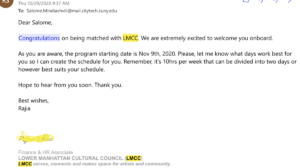
I have been an interning at LMCC since November 2020. Our communications & marketing team consists of Sophie, Director of Marketing & Communications, JoAnn who is a full-time communications and marketing associate, and Sunny, part-time communications associate.
Lower Manhattan Cultural Council | My Internship Organization
My internship organization, Lower Manhattan Cultural Council (LMCC) is a non-profit organization that empowers artists by “providing them with networks, resources, and support, to create vibrant, sustainable communities in Lower Manhattan and beyond”.
The organization was founded in 1973 by Flory Barnett with support from David Rockefeller on the idea that artists were pillars of resilience and inspiration and therefore vital to New York City.
“LMCC Mission: To create a fertile and nurturing environment for artists and arts groups, enlivening public spaces with free programs in the visual, performing, and new media arts, and to provide leadership in cultural planning and advocacy.”
In 2015, LMCC awarded approximately $500,000 in grants, provided 500 individuals with professional development skills, placed 100 individuals and arts groups in studio residency programs, as well as presented over 60 days of free cultural experiences for the public to enjoy.
At LMCC, I was hired as a Communications & Marketing Intern to support a team of communication designers and marketing professionals through a CUNY Cultural Corps., -“the program which creates opportunities for CUNY students to work in the City’s cultural sector.”
Ethics Assignment | Entry 2
A) Reading the resources on ethics in graphic design and advertising has broadened my understanding of the field and has given me more of a critical eye for the visuals/advertisements I look at or create myself.
In the past, I have always tried to create my own unique work and have not really used another’s creative work besides music. In the case of a video montage for school projects, whenever I would not use royalty-free music, I would always credit the musician at the end of the video.
B) I believe that the outcome of the Fairey Copyright case in which the artist Shepard Fairey agreed not to use another AP photo in the future without obtaining a license first was fair considering that this was the first major copyright dispute he had been involved in. It is also interesting how the AP has requested to share the rights to make the posters and merchandising bearing the Hope image after realizing that this was a huge hit for the people. Associated Press really took the advantage of this “unfortunate” situation and used it for themselves as well.
Having mentioned the Hope poster, I must share one of the recent works by Fairey Shepard that unveils a cover image on the latest issue of Time magazine. The poster showing a woman using a bandana as a face covering is made in the same style as the Hope poster. In this poster, Fairey Shepard tries to communicate ideas of racial discrimination, voter suppression as well as anti-mask and anti-vaccine campaigners in the age of Covid-19.
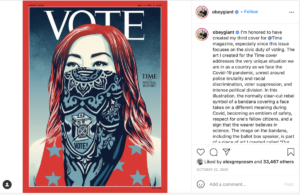
References:
Memmott, Mark. “Shepard Fairey And AP SETTLE Copyright Dispute OVER ‘hope’ Poster.” 12 Jan. 2011. Web. 24 Mar. 2021.
Ethics Assignment | Entry 1
Being a communications and marketing intern at Lower Manhattan Cultural Council entails researching, creating, copywriting and sharing the art-related content on online platforms such as Twitter, Facebook, Instagram, and website homepage. This is also referring to 1-2 associative images per day that are being embedded with the social media posts, news articles, and monthly newsletters. From the very beginning of my internship experience, I was impressed and fascinated by how professional the communications team at my placement company was at handling the images, reaching out to the artists for permission as well as attributing the artists and the photographers alike.
At the beginning of each week, I am usually given a social media schedule that includes daily posts for all social media platforms and website news post updates. If the schedule is not already determined, then we do the online research on the alumni artist news and find the appropriate events/shows to promote. In this process, image selection is one of the early and the most important stages since LMCC strives to keep the overall look of its platforms fun, colorful and dynamic.

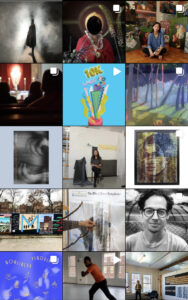
For every single image the organization has used for the social media post, there has been a rigorous practice of first getting permission from the artist/groups and then the accurate attribution in the image credit section at the bottom of each post. Since one of the goals of my internship organization is to promote the work of New York City artists, most of them are already within our network and can easily be DM’ed through Instagram or via email for image/repost permission. However, we sometimes had delays in responses and because of that, had decided against posting about the artist/show without getting the permission first.
The photographs I have taken of artists-in-residence at LMCC Arts Center at Governor’s Island have been shared multiple times on our and other NYC art residency-related pages and they all have been credited to me.
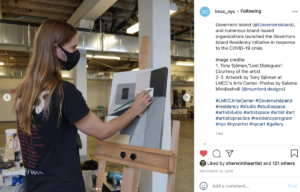
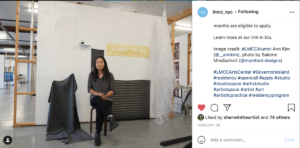
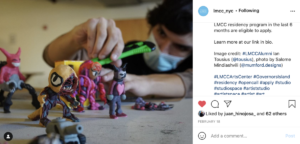
The same thing with the 10K followers celebratory graphic post I have created for Lower Manhattan Cultural Council, my name was credited at the bottom of the post which shows the professionalism and artistic appreciation from my internship organization.
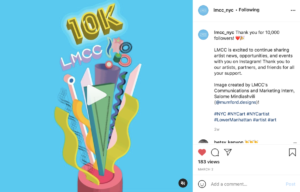
In the case of an unknown photographer, we always say “Image courtesy of an artist (name)”.
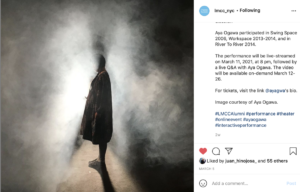
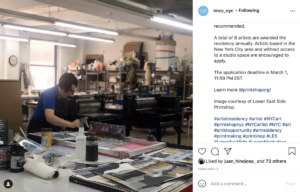
I have learned so much from this rigorous practice of image selection and attribution that when using images in the future, I will always strive to adhere to these same rules in whatever direction I choose to go in my career path. Seeing my photographs/work being attributed to me has made me realize how important it is to always mention the author, not just for legal matters but out of sheer decency as well. Perhaps, I would never truly experience this special feeling without taking initiative in actively participating in this internship, taking photographs, or producing graphic work for various communications.




